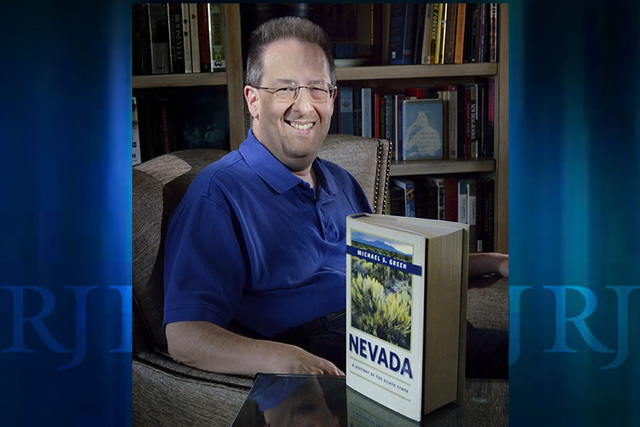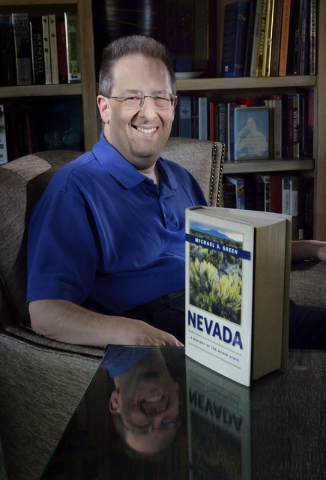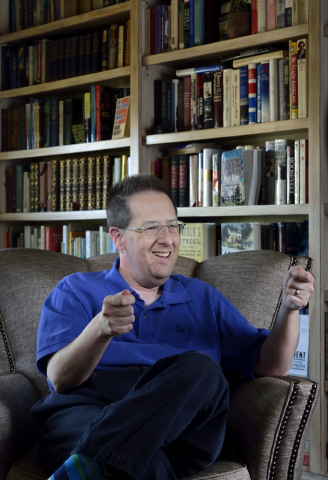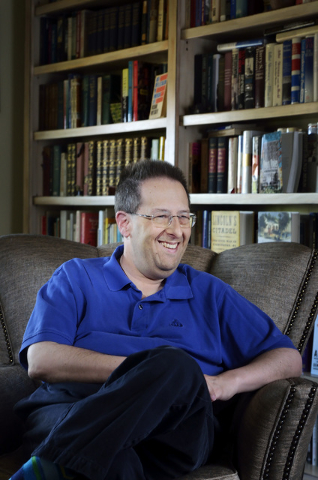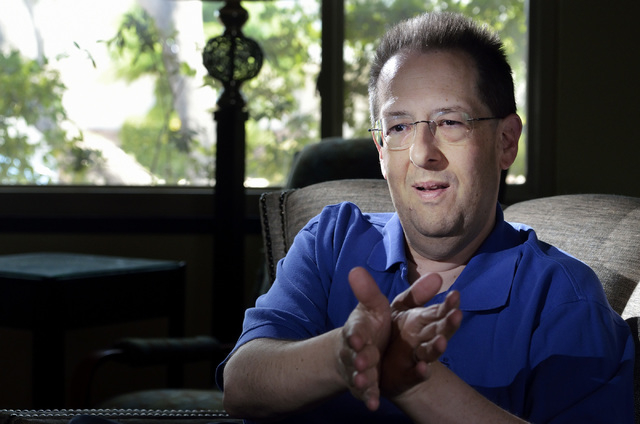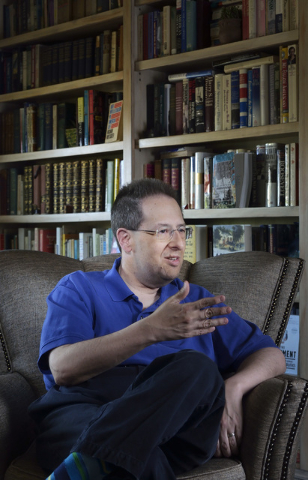UNLV professor’s book explores Nevada’s weird, wonderful history
Michael Green knows them all.
The scalawags, the thieves, the killers, the saints, the sinners, the heroes, the odd fellows and just about everyone, and everything, that had or has something to do with Nevada’s evolution.
Not personally, of course — at least not in most cases — but as a historian, teacher and go-to media source for writers and reporters seeking to put today’s events into perspective.
And now, Green, an associate history professor at the University of Nevada, Las Vegas, puts all of Nevada’s past into context with “Nevada: A History of the Silver State” (University of Nevada Press, $45 cloth, $26.95 paper).
Although designed as a college textbook, it is a readable reference for anyone looking for details of Nevada history.
Green, a nearly native Nevadan, is the perfect guy to tell the state’s story. As he discusses his book, the conversation often drifts into parenthetical sidelights and odd historical tidbits that seem to be embedded into the Silver State’s past like neon-colored strands in an otherwise staid tapestry.
Nevada is, and always has been, interesting, Green says.
Begin with social and economic forces that have made Nevada a real-life equivalent of Rick’s Cafe (for “Casablanca” fans) or Mos Eisley Cantina (for “Star Wars” fans). Thanks to mining and tourism, Nevada’s main industries, “you have this constant flow of people in and out, and you constantly have this group of people who are trying to make a living off of the people moving in and out,” Green says.
Granted, that kind of diverse nomadism also can make Nevada’s story tough for historians to tell.
“(These transient people) don’t have the tendency to stay around long enough to say, ‘OK, I’m going to leave a diary or papers to the archive’ or whatever it is,” Green says. “But it also means they tend to do some interesting things along the way.”
“Years ago, I did a middle school textbook and the publisher said, ‘We’d like to include profiles of inspiring businesspeople,’ ” Green recalls. “Bugsy Siegel and Moe Dalitz?”
He laughs.
“Well, Moe Dalitz really was an inspiring businessperson. But Bugsy? Not so good a businessman.”
Also complicating the telling of Nevada’s history in general and Las Vegas’ history in particular, Green says, is that many mobsters or people who worked in casinos came out of illegal operations.
“They didn’t try to draw attention to themselves. So you’re not going to see Moe Dalitz take out an ad in the RJ saying, ‘Hi, I’m from the Cleveland Mob,’ or ‘This is how I made this sweetheart deal.’
“You have to do a little more assuming or extrapolating than in some other places,” Green says. “You do have to do a little more guesswork and look at unusual sources. I don’t think most people writing history in other places are likely to look in FBI files.”
Green says he began the project aiming to write a college-level textbook. It represents, he adds, the first new, in-depth survey of Nevada published since 1989.
As Green researched the book, he faced the challenge of deciding which parts of Nevada’s broad story to leave out and which to leave in.
“And in terms of leaving something out, there are myths, and we know they’re myths,” he says, “but sometimes we have to address (the myth) to clear up the myth.”
Green says he tried to incorporate necessary basics, such as Nevada’s geology, into the book as part of both thematic and chronological narratives. The result is a history book that often doesn’t read like a history textbook.
“One of the beefs I’ve had with many state history textbooks is that they’re, ‘Here we have our chapter on Native Americans, here’s our section on women, here’s our section on African-Americans,” Green says.
“I realized how tough (organization) is once I got into the book, but I wanted to make sure I was being both chronological and topical. Pick up the final chapter and the final chapter is about current events, or fairly current events.”
Green has studied Nevada history for most of his life. He was 2 years old when he and his family moved from Los Angeles to Las Vegas, and although he doesn’t remember much formal instruction in Nevada history, he did enjoy the subject.
“My first unpublished volume,” Green says, smiling, was “a history of the presidency,” dictated to his apparently very patient mother based upon facts gleaned from kids’ books of the time.
Green says he wanted to be an announcer for the Dodgers. When he was 9, his parents took him to Los Angeles to attend his first Dodgers game, and Green got to visit the announcer’s booth to meet legendary announcer Vin Scully.
Green previously had written to Scully to ask him how to become a baseball announcer.
“He said, ‘Be an English major.’ Good for him.”
And that in-person visit?
“He looked down at me and said, ‘So you’re the guy who wants my job.’ And my response was to stand there gaping at him. In fact, I had nothing to say the entire time. I think I did manage to get out a thank you when he showed me out of the booth.”
But, during a visit to the North Las Vegas library, Green found a book in which he discovered that Nevada had a governor named Mike — Mike O’Callaghan, who served from 1971 to 1979 — and Green began to think of a different career.
“I thought I’d be a journalist,” Green says.
In 1982, when Green was 17, Bob Brown, then publisher of the Valley Times, hired Green as a “kid reporter,” Green recalls, which meant doing anything from ripping stories off of the wire machine to covering cops to, even, covering Ronald Reagan’s visit to Las Vegas when Green was a UNLV freshman.
UNLV didn’t offer many journalism courses then.
“I thought maybe I’d be better off, if I wanted to go into journalism, to study something related to it,” Green says. “I loved history, and they had very good professors at UNLV, and that sealed the deal.”
After earning bachelor’s and master’s degrees at UNLV, Green enrolled at Columbia University to study for a doctorate. Later, after returning to Las Vegas, he landed a part-time job at the then-Clark County Community College, teaching Nevada history.
Green taught at now-College of Southern Nevada for 19 years, and just completed his first full-time year at UNLV, which, he says, has been a joy.
UNLV’s history department Chairman Paul Werth said that when the opportunity arose for Green — who had been teaching part time in UNLV’s honors college — to join UNLV’s full-time faculty, it made sense.
“Very few people, perhaps no one at all, has the experience he has in Nevada history, with the possible exception of (UNLV history professor) Gene Moehring,” Werth says.
Although students know him as a teacher and readers of his book will know him as an author, other Southern Nevadans also might recognize Green as an oft-quoted source for newspaper, magazine and TV pieces involving Nevada history, politics and popular culture.
“When you do local history, there’s a pretty good chance that’s going to happen,” Green says.
He recalls talking with Frank Wright, a noted Nevada historian who for years wrote a popular weekly Nevada history feature aired on KNPR-FM (88.9), shortly before Wright died.
“He was dying, and I said, ‘Frank, you can’t go. You’ve got to be here to keep taking those telephone calls,’ ” Green says, smiling. “Frank said, ‘It’s OK. You can have ’em.’ So I do get those calls.”
“But the other thing is, historians do have something to say,” Green adds.
Once, during a talk to a Sun City club, somebody asked Green, “Why aren’t more people interested in community?”
Green called for a show of hands.
“‘How many of you moved here in the last five years?’ All but two or three people out of 50. ‘OK, how many (in) the past year?’ At least half a dozen, maybe more.’
“When you’re new and learning the community, (you) learn history, too,” Green says. “So if I could help with that, great. (Also) I don’t think it’s a bad thing for faculty … to be seen in the community and be seen trying to do useful things in the community. It might remind people these are valuable institutions worthy of funding.”
Contact reporter John Przybys at jprzybys@reviewjournal.com or 702-3823-0280 or follow @JJPrzybys on Twitter.
Michael Green’s "People Who Shaped Nevada — From Way Outside Nevada"
Jessie Benton Fremont — Jessie Benton Fremont’s father, U.S. Sen. Thomas Hart Benton, believed in westward expansion. Jessie met and married a young army officer and explorer, John C. Fremont, and Jessie’s father promoted his son-in-law’s explorations of the West. Jessie worked with her husband in writing best-selling reports that put much of Nevada, including Las Vegas, on the map and provided vital information to future travelers.
Abraham Lincoln — In 1861, as new U.S. president, Lincoln appointed territorial officers who set up the early government. Hoping to be re-elected, and wanting support for the 13th Amendment ending slavery and for his policies to reconstruct the Union, Lincoln supported Nevada’s statehood in 1864. By supporting and signing the Pacific Railroad Acts, he backed the building of the Central Pacific, which helped shape Nevada’s landscape, politics and society. By doing the same for the Morrill Act, he aided creation of new colleges and universities, including what is now the University of Nevada, Reno.
Earl Warren — The U.S. Supreme Court chief justice’s opinion on school desegregation wasn’t all that he did. Warren said the most important opinions of his tenure were on legislative reapportionment, which reshaped the Nevada legislature so that urban areas such as Las Vegas and Reno had more representation. Before that, as California’s attorney general, he ordered raids on gambling boats off the coast, and some of the men who operated or worked on them — including Sam Boyd and Tony Cornero — would later play a role in gaming here.
Fidel Castro — Shutting down Havana’s casinos meant some of the employees from Cuba relocated to Las Vegas, helping to shape the modern Hispanic population, and mob investment was directed this way. Castro’s role in the Cold War contributed to defense programs at military bases and the Nevada Test Site, which boosted the state’s economy and population.
Alan Turing/Jack Kilby/Tim Berners-Lee, inventors of computers and the World Wide Web and improvements in them — While everyone’s lives would be different without them, think of how they have affected the population and wide open spaces of Nevada, where we can watch and participate in legislative hearings as they happen in Carson City from 400 miles away in Las Vegas, or take university classes in Eureka or Battle Mountain. In Las Vegas, computerized games have redesigned the casino floor away from the total emphasis on table games and, thus, affected the workforce.



